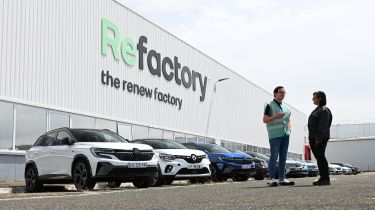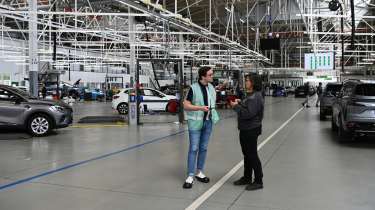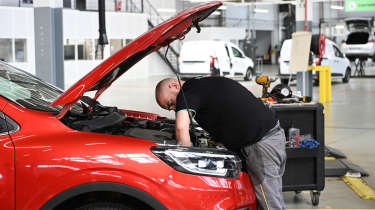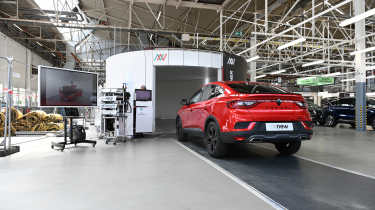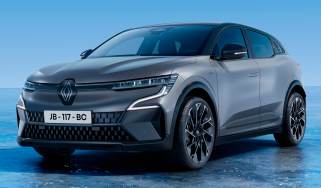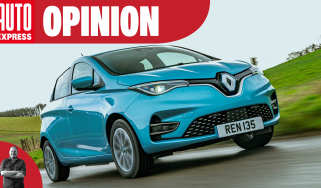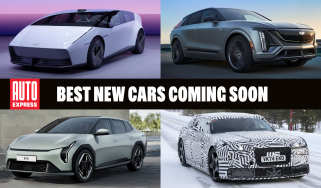Renault's Refactory: inside the groundbreaking repair, restoration and recycling hub
We go behind the scenes at Renault’s Refactory car recycling centre
It’s been 80 years since the D-Day landings of World War 2 – and it’s fair to say that today’s consumerist society could learn a lot from the resourcefulness of those living in those dark times. Back then it wasn’t called recycling, but the concept of repairing and reusing one’s possessions was not only morally correct, but outright expected.
Yet while the challenge of climate change that we face today is very different to the situation faced by 1940s Europe, we’re once again expected to do our bit, this time for the environment. If we’re all expected to make changes to our lives, though, then why shouldn’t the same apply to large corporations?
While many car manufacturers have already pledged to electrify their ranges to reach net-zero carbon emissions, it could be argued that doing so is a form of greenwashing – neglecting the fact that to be truly sustainable, the automotive industry also needs to consider adopting a ‘circular economy’ in which everything is reused and recycled.
One of the handful of firms to embrace this philosophy is Renault, which has created a new ‘The Future is Neutral’ sub brand, dedicated to investment and innovation in the field of sustainability – the first of its kind globally.
The Future is Neutral (TFIN) is based at the state-of-the-art Refactory; a large facility near Paris which has undergone a transformation since it first opened in 1952 as a manufacturing facility for the Renault 4 CV and Dauphine cars.
We’re greeted at the gates by chief technology officer, Sophie Schmidtlin, who gives us a brief overview of the brand’s vision. “Everyone’s focused on decarbonisation,” she said. “People haven’t realised that the circular economy is important – we can’t keep doing things the way we have.”
This outlook is reflected in the Refactory’s 1,200+ employees who have all been retrained from typical automotive assembly-line skills to that of disassembly, repair and restoration. As its name suggests, the Refactory aims to give end-of-the-road Renaults a new lease of life.
Each section of the Refactory is home to a different subsidy of The Future is Neutral, with the first one – the Remakers – joining the fold earlier this year as a way to break down older or damaged vehicles into individual parts and components that can be reconditioned and reassembled as new ‘organs’ – much like Lego.
Renault says that roughly 85 per cent of each of its vehicles is recyclable, rising to up to 95 per cent for newer models such as the new 5. The Remakers, on the other hand, ensure there is no waste in their reverse engineering; 92 per cent of parts are refurbished and reused in different applications, while the remaining eight per cent are fully recycled. This means that each refurbished part may not end up in the same type of application in which it started out – being disassembled from a cylinder head and finding its way into an exhaust manifold, for example.
“You can’t just say it’s good for the planet,” we were told by Schmidtlin. “It needs to be good for the consumer and also profitable.” On average, the price of a remanufactured part is roughly 30-40 per cent cheaper than a new one, while also maintaining the same guarantee of quality from the manufacturer. That’s not to mention the 85 per cent energy saving in the manufacturing process and recycling of precious materials.
Many of these remanufactured parts find their way to one of the other sections of the Refactory: the Renew Factory. Home to Renault’s manufacturer-approved used vehicle programme, the team here perform as many as 80-100 repairs per day, with an average of 10 days spent on each vehicle.
While this sounds like a glorified used car workshop, the Renew Factory takes steps to make the process as sustainable as possible. For example, paintless dent removal saves 12,000 litres of paint per year and recycling heat from spray booths in order to conserve energy.
Sometimes, however, more complex repairs are needed – such as in regard to electric car batteries. This is where another TFIN subsidiary and Refactory tenant comes in. GAIA is dedicated to the repair and maintenance of EV batteries. Having repaired roughly 12,000 battery packs since 2011, GAIA’s battery repair centre is one of the most sophisticated in Europe, allowing for more in-depth diagnostics than other facilities.
We’ve all heard stories about someone needing to replace the battery in their EV, only to be faced with a bill that can exceed the value of the car itself. GAIA’s repair service, on the other hand, is much cheaper than buying a whole new battery pack and comes with a quality guarantee from Renault itself. Not only is this less expensive at face value, but the popularisation of battery repair may bring down the price of EV insurance for all – something that’s currently inflated due to the astronomical cost of a new battery pack.
However, there are times that a replacement battery pack is the only option – such as after an accident, when the battery can be impossible to repair. All’s not lost, though, as GAIA has started offering a service that will recycle the damaged battery and offer the customer a choice of either a brand new battery pack or one that’s been refurbished. The benefits are clear, with refurbished batteries coming with a smaller environmental impact and a price that’s as much as 30-40 per cent cheaper than sourcing a new replacement.`
The team at GAIA estimates that the life span of an EV battery is roughly 15 years with proper maintenance and repairs, so you may be wondering what happens afterwards. The obvious solution would be to recycle the battery unit, yet GAIA believes there is still use for these discarded batteries even then.
While their usable capacity after 15 years won’t be sufficient for powering something that consumes as much power as an electric car, GAIA is already giving old batteries a new life as energy storage units for the main grid, as well as for use in rapid chargers that lack a direct grid connection. The firm has even sent out EV batteries to support the war effort in Ukraine, which have been upcycled into mobile energy storage units for makeshift hospitals.
Ultimately, the aim for GAIA and TFIN is to integrate what’s known as a ‘closed loop’ system in which, at the end of life, all of the materials that make up an EV battery are recycled and used to build a brand new one. This type of methodology is already being implemented in China, and while precious metal yields from the recycling process are currently quite low, over time this will increase as methods are refined, coinciding with tougher regulations imposed by the European Union.
There’s a long way to go until the automotive industry attains its vision of sustainability and circularity. With governments taking steps to tighten regulations, Renault’s Refactory will soon be one of many. But for now it is as an example of how car manufacturers can repurpose their customers’ end-of-life vehicles in a sustainable manner if they put their minds and money into it.
A classic has returned! Read our review of the new Renault 5...
Find a car with the experts

